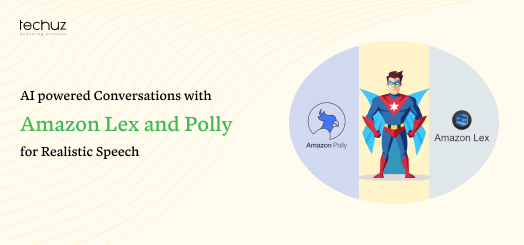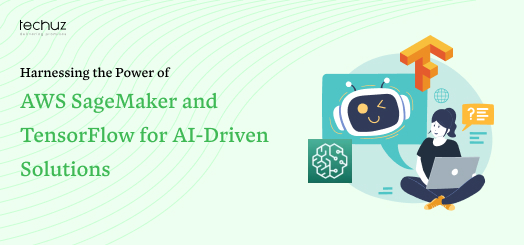Posted on
October 14, 2024
Read time
 11 mins read
11 mins read
Quick Summary –We are getting to see more and more voice-driven applications in the changing face of artificial intelligence. The two AWS services that form a very vital part of this include AWS Polly and Amazon Lex. Above all, Polly is fantastic when it comes to text converted into almost realistic speech, while Lex supports the development of more complex conversational interfaces. Together, they empower developers to build highly interactive voice-driven applications such as virtual assistants and intelligent IVR systems, among many more.

Table of Content
1. Introduction to AWS Polly and Amazon Lex
Voice technology is fundamentally redefining the way people interact with digital systems. Among the newest services provided by Amazon Web Services, perhaps two of its most exciting services are AWS Polly and Amazon Lex. AWS Polly – Amazon’s text to speech service that converts written text into natural-sounding speech, whereas Amazon Lex is a service that empowers developers to create conversational interfaces using both voice and text. In total, these services provide a comprehensive platform for developing voice-enabled applications, from virtual assistants to IVR systems.
Voice technology has rapidly advanced in the past couple of years, majorly due to the advancement of AI and NLP. The future transformation is mostly at the top as it keeps improving to come up with tools to make application development easier with human-like interactions for developers mainly through AWS Polly and Lex services. These services enable businesses to provide customer experiences, smooth processes, and innovate the voice tech space.
2. Technology Behind AWS Polly
How AWS Polly Converts Text to Speech?
AWS Polly uses advanced deep learning to deliver high-quality, natural-sounding speech. Most of the text-to-speech systems sound like a robot-like voice, whereas Polly’s NTTS models generate voices that are more human-like and expressive. This is achieved by taking written text and turning it into a spoken format that captures the subtleties of human speech-intonation and emotion.

Polly also offers multiple speech features that can enhance web development for startups:
Speech Marks – Provides timing details for speech elements like phonemes, words, and sentences, helping developers optimize voice interactions in web applications.
SSML (Speech Synthesis Markup Language) – Allows web developers to fine-tune speech features like pitch, rate, or volume, enabling highly customizable voice outputs.
These capabilities help startups build tailored, voice-driven web development, enhancing user engagement and experiences.
Supported Languages and Voices
With respect to wide targeting, AWS Polly supports a wide range of languages and voices. Developers can choose from multiple languages such as US/UK English, Australian, Spanish, French, German, Japanese, and many more. In addition, for all languages, there are male and female voices available, thus more flexible localized and personalized applications.
With the many different voices and languages available in Polly, applications can deliver more inclusive and engaging experiences for users. Inasmuch as businesses want to talk to and serve larger audiences through the delivery of natural-sounding voices in multiple languages, Polly is quite helpful.
3. Deep Dive into Amazon Lex
Natural Language Understanding and Conversational Interfaces
The technical design of Amazon Lex is to make conversational interfaces whereby human and application interactions are natural and intuitive. It does so using the most advanced NLU and ASR technologies developed by Amazon in order to interpret user intents and provide appropriate responses accordingly.
In Lex, developers can identify what are called “intents”-actions they want the user to perform-and “slots”-parameters required to execute that intent. The travel booking bot might have intentions to book flights, hotels, or car rentals, but with slots for the necessary parameters-for example, dates of travel, destination city or town, passenger names.

4. How Polly and Lex Interact
Seamless speech synthesis and dialogue management
AWS Polly and Amazon Lex combine to powerfully build voice-driven applications. Polly will create a text-to-speech capability, meaning it translates the bot’s response to natural, human-like speech, while Lex manages the dialogue with the user, interpreting the commands and controlling the flow of the conversation.
This integration empowers applications to deliver smooth, interactive experiences. For example, in a customer service application, Lex would be able to work out what a user’s query is, process the query, and Polly will render it as a spoken answer, which would then create a normal and excitingly interactive experience.
Architecting an AI Voice Application
To design an AI voice application using Polly and Lex, several steps are critical:
Define the use case: Why do you want to build a voice-driven application and how are you going to use Polly and Lex.
Setting up AWS Polly: setting up a speech synthesizer with Polly, choosing appropriate voices and languages for the application.
Creating a Lex Bot: designing and building out a Lex bot, handling user interaction as well as defining the intent and slots.
Integrate Polly and Lex: Connecting Polly and Lex through AWS SDK, so that Lex’s dialogue output is converted to speech in Polly.
Through the above steps, developers can build powerful voice-driven applications utilizing all the strengths of Polly and Lex.
5. Key Use Cases
- Virtual Assistants
Use Case: Virtual assistants can be an AI-driven system developed to accomplish tasks and give information based on users’ mandates. As such, it is quite handy to use for scheduling, reminders, and information retrieval, among others.
Real-Life Implementation:
Example: Amazon Alexa is one of the most famous virtual assistants; in its implementation, AWS Polly is used to produce human-like sounding responses whereas Amazon Lex is used to manage the flow of conversations. Consumers can use Alexa for listening to their favorite music, for controlling smart home devices, for reminding them about events, or for giving them real-time information on weather conditions. Interactivity between text-to-speech and conversational interfaces makes the interaction intuitive and engaging.
- IVR Systems
Use Case: IVR systems are guiding the telephone-based customer interaction of an organization. The systems allow a company to route calls, receive information, or make service requests.
Real-Life Integration:
Example: Banking IVR Systems Many banks use IVR systems for customer service. An IVR system could utilize AWS Polly for natural-sounding instructions while Amazon Lex handled what the user had entered to forward the call to the right department, check the balance of an account, or initiate a transaction. This means there’s less waiting time and greater customer satisfaction.
- E-Learning Platforms
Use Case: Using voice technology in e-learning platforms enables a developing interactive learning experience, such as voice-guided tutorials, language learning applications, and accessibility features for visually challenged students.
Real-Life Incorporation
Example: Languages Apps: Duolingo used voice technology for pronunciation guidance and exercises. AWS Polly would provide the pronunciation for words in your vocabulary list, natural and clear, while Amazon Lex could simulate conversations by having the app engage users in a dialogue designed to improve their language skills.
- Smart Home Automation
Use Case: The smart home automation system lets the user control his environment at home with a voice command-yes, change the brightness, set the thermostat, or even control his home security system.
Example: Google Nest Hub: Smart home gadgets like Google Nest Hub utilize voice technology in managing various aspects of the homes of the customer. AWS Polly returns read-through responses back to the consumer. Amazon Lex takes the voice inputs and processes them to take actions such as changing thermostat settings or activating lights. This creates a hands-free experience for the smart home.
- Customer Support Bots
Use Case: Customer service bots answer most of the frequently asked customer queries, handle simple queries and support automated conversations and reduce usage of live agents and improve response time.
Real Life Incorporation:
Example: Retail Customer Service Chatbots: Many retailers use chatbots to help with orders, returns, and product information. So, for instance, the retail chatbot can leverage Amazon Lex to interpret the user query and AWS Polly to enable spoken responses or text-based audible ones. All that comes together to create a more pleasant customer experience, based on how efficiently and accurately the information is provided.
- Healthcare Helpers
Example Application: Healthcare assistants use voice technology to assist in interacting with patients in relation to scheduling appointments, reminding them of medication, and advising on health care.
Real-Life Application:
Example: Health Monitoring Systems: Such systems as Care.com make use of voice technologies to enable a patient to monitor their health. AWS Polly can hence provide instructions on how to administer medications or health tips. In this case, Amazon Lex will handle the conversational features and enable a user to ask health queries.
- Travel and Hospitality
Use case – Travel and Hospitality Business: This is attributed to the fact that the voice technology enhances customer experiences in areas such as provision of booking services, information on travel, and responding to guests’ requests.
Practical Application:
For instance, Hospitality Concierge Services: Marriott leverages voice assistants for numerous guest services. Using AWS Polly, you receive natural-sounding responses to guest inquiries; using Amazon Lex, the guests can schedule table reservations at a local restaurant, order room service, and recommends what local attractions might be of interest. All of this helps with guest satisfaction and running much more efficiently.
- Entertainment and Media
They should utilize voice technology to come up with a voice and media house that entertains people, such as when creating an interactive storytelling experience; adding voice-guided content; and immersive audio experiences.
Real-Life Use Case Incorporation
For example, companies such as Audible use AWS Polly to narrate audiobooks with lifelike voice quality. Amazon Lex can be used to allow the users to ask questions about book content or navigate through chapters-this adds to the listening experience of the audiobooks made interactive and user-friendly.
6. Example Product: Voice-Controlled Smart Home Assistant
Imagine we wanted to create an example product: a voice-controlled smart home assistant. Using AWS Polly and Amazon Lex allows for an interactive response from this product as if it were in motion.
The intelligent assistant allows users to control several smart home devices via voice commands. This intelligent assistant can actually control activities such as turning lights on/off, adjusting thermostat levels, and listening to music. Users interact with the assistant via voice commands while the assistant gives oral responses and status updates to users.
Implementation Steps
Configure Intents and Slots in Amazon Lex for all the various commands such as turning light on/off, thermostat on/off, etc. Define the required slots for parameters of name of device and settings.
Configure AWS Polly: Select an appropriate voice set along with the language in Polly to deliver a natural sound response. Configure speech synthesis features to make the output more plausible and palatable.
Combine Lex and Polly: Connect Lex with Polly so the output of voice can be processed. Ensure Lex’s text is converted into speech by Polly.
By integrating these services, developers can make a smart assistant that can offer a more real user experience.
7. Building a Voice-Activated App with AWS Polly and Amazon Lex Step by Step
Setting Up Polly for Speech Synthesis
- Open an AWS Account: Sign-up in case you do not have an AWS account
- Access AWS Polly: Navigate through the AWS Management Console to AWS Polly
- Select Voices and Languages: Select the best fitting voices and languages for your application
- Speech Output Testing: Use Polly’s console to perform a speech output test for the defaults. Where necessary, adjust settings!
Develop a Lex Bot for Conversation
Access Amazon Lex Go to the AWS Management Console and navigate to Amazon Lex.
Define Intents and Slots: Design intents and slots that define the set of commands your application will respond to.
Set up Lambda Functions: Define AWS Lambda functions to accept the invocation input from users and return a response.
Test the Lex Bot: Test the response and flow of the dialogue for the bot in the test console provided by Lex.
Integrate Polly and Lex for Voice Interaction
Lex and Polly: Connect them using AWS SDKs or APIs to output voice.
Voice Interaction: Set up your application to interact with voice input and voice output so that the interaction between Lex and Polly is seamless.
Testing and Tuning: Test all types of testing to ensure that your integration works correctly and fine-tune as necessary.
For a deeper Understanding on how polly and lex work together , refer to this video
8. Conclusion: The Future of Voice-Driven AI with AWS Polly and Amazon Lex
The years ahead, AWS Polly and Amazon Lex are heading to change the face of the future voice-driven applications. With such powerful tools, developers can create very interactive, engaging, and user-friendly voice applications that fit all sorts of needs.
The integration of Polly and Lex, on the other hand, offers a holistic solution that relates to building voice-driven experiences, from virtual assistants to smart home systems, as technology moves forward with new functions and improvements in these services.
Today embracing AWS Polly and Amazon Lex is going to place businesses, and developers, in the best position to take off with voice technology and capitalize on growing demand for new, interactive, and intelligent voice applications – the future of voice-driven AI.








